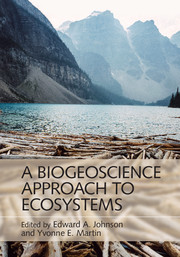Book contents
- Frontmatter
- Contents
- List of contributors
- Preface
- Miscellaneous Frontmatter
- 1 Introduction
- Part I Connecting Ecosystem and Geoscience Processes
- Part II Transport Processes and Conservation Budgets in Biogeoscience
- Part III Coupling Hillslope Geomorphology, Soils, Hydrology, and Ecosystems
- Part IV Coupling Fluvial and Aeolian Geomorphology, Hydrology/Hydraulics, and Ecosystems
- Index
- References
Preface
Published online by Cambridge University Press: 27 October 2016
- Frontmatter
- Contents
- List of contributors
- Preface
- Miscellaneous Frontmatter
- 1 Introduction
- Part I Connecting Ecosystem and Geoscience Processes
- Part II Transport Processes and Conservation Budgets in Biogeoscience
- Part III Coupling Hillslope Geomorphology, Soils, Hydrology, and Ecosystems
- Part IV Coupling Fluvial and Aeolian Geomorphology, Hydrology/Hydraulics, and Ecosystems
- Index
- References
Summary
We are not students of some subject matter but students of problems. And problems may cut right across the boundaries of our subject matter and disciplines.
– Karl Popper, 1963. Conjectures and Refutations: Growth of Scientific Knowledge.This is not an ecosystem textbook in the usual sense in being primarily about biology but rather it is a collateral book that introduces the physical environment into ecosystems using a biogeoscience approach. Why do this? A biogeoscience approach uses: 1) process- or mechanistic-based approaches and 2) formal (mathematical) models of governing equations that involve transport processes and continuity or conservation equations. Ecology has, in general, viewed the physical environment as a black box, using simple arrows to indicate the connections between the physical environment and ecological systems, but with minimal or no consideration of the operation of these physical environmental processes. The reasons for this are varied, but may be attributed partly to different approaches of problem solving in biological vs. geophysical sciences and to both disciplines not always understanding how the other could be connected in more than a descriptive or correlational manner.
The purpose of this book is to take advantage of progress in the geosciences (including geomorphology, soil science, hydrology, and meteorology/climatology) to advance the understanding of ecosystem science. The goal is to present these geoscience developments in a manner such that ecologists who have had limited exposure to these ideas and methods can gain an introduction and understanding of how these couplings can be used in ecosystem science. We intend the book not to be a hopeful discussion of what we should or could be doing to tie the disciplines together, but rather to be a set of chapters providing examples of explicit approaches and procedures of how such research has coupled successfully the fields of ecology and geoscience.
A quick look at the research areas of biogeoscience (Table 1.1) will note large and very active topics (e.g., geomicrobiology) that are not considered in this book. It is easy to think of topics that we could (should) have included in this book.
- Type
- Chapter
- Information
- A Biogeoscience Approach to Ecosystems , pp. xi - xiiPublisher: Cambridge University PressPrint publication year: 2016

